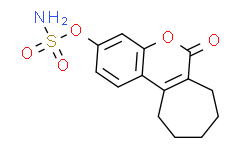| Cas No.: | 288628-05-7 |
| Chemical Name: | Sulfamic acid,6,7,8,9,10,11-hexahydro-6-oxobenzo[b]cyclohepta[d]pyran-3-yl ester |
| Synonyms: | Sulfamic acid,6,7,8,9,10,11-hexahydro-6-oxobenzo[b]cyclohepta[d]pyran-3-yl ester;(6-oxo-8,9,10,11-tetrahydro-7H-cyclohepta[c]chromen-3-yl) sulfamate;667-COUMATE;Bn83495(stx64);BN 83495;STX 64;667 Coumate;Irosustat |
| SMILES: | O=C1OC2=CC(OS(=O)(N)=O)=CC=C2C3=C1CCCCC3 |
| Formula: | C14H15NO5S |
| M.Wt: | 309.3376 |
| Purity: | >98% |
| Sotrage: | 2 years -20°C Powder, 2 weeks 4°C in DMSO, 6 months -80°C in DMSO |
| Description: | Irosustat is a potent steroid sulfatase inhibitor, with an IC50 of 8 nM, and exhibits anti-breast cancer activity. |
| Target: | IC50: 8 nM (Steroid sulfatase)[1], 0.2 nM (Steroid sulfatase, MCF-7 cells)[2] |
| In Vivo: | Irosustat potently inhibits rat liver, with inhibition of >90% when at a 1 mg/kg concentration. Irosustat (2 mg/kg, p.o. for 5 d) blocks the uterine growth stimulated by oestrone sulfate (E1S) in ovariectomized rats. In addition, Irosustat (2, 10 mg/kg, p.o.) plus E1S dose-dependently decreases the growth of NMU-induced mammary tumors in ovariectomized rats[1]. Irosustat (667 COUMATE; 10 mg/kg, p.o.) shows 97.9 ± 0.06% inhibition on steroid sulphatase (STS) activity in rat liver[2]. |
| In Vitro: | Irosustat (667 COUMATE) is a potent steroid sulfatase inhibitor, with an IC50 of 8 nM[1]. Irosustat (667 COUMATE) inhibits steroid sulphatase (STS) activity in MCF-7 cells with an IC50 of 0.2 nM, but has no effect on the morphology or proliferation of MCF-7 cells at 10 μM[2]. |
| Cell Assay: | MCF-7 cells are cultured in growth medium (minimum essential medium (MEM) containing, phenol red, 10% foetal calf serum (FCS) and essential nutrients). When the cells reach 60% confluency, they are treated with Irosustat (0.001-10 μM) in growth medium. After 72 h of incubation, photographs are taken under normal conditions of light and the number of attached cells in each flask is determined using a Coulter cell counter[2]. |
| Animal Administration: | Rats[1] Ludwig rats bearing mammary tumors are used in the assay. Tumor development is monitored, and animals are ovariectomized when tumors reach 0.8-1.5 cm in diameter. Tumors are allowed to regress over a 12- to 13-day period to confirm their hormone-dependent status. Regrowth of tumors is stimulated with oestrone sulfate (E1S; 50 μg/day, s.c.). When tumors have regrown, animals continue to receive either E1S alone or E1S plus Irosustat at 10 mg/kg/day or 2 mg/kg/day, p.o., until tumor regression has occurred. Tumor volumes are calculated from two measured diameters[1]. |
| References: | [1]. Purohit A, et al. In vivo inhibition of estrone sulfatase activity and growth of nitrosomethylurea-induced mammary tumors by 667 COUMATE. Cancer Res. 2000 Jul 1;60(13):3394-6. [2]. Raobaikady B, et al. Inhibition of MCF-7 breast cancer cell proliferation and in vivo steroid sulphatase activity by 2-methoxyoestradiol-bis-sulphamate. J Steroid Biochem Mol Biol. 2003 Feb;84(2-3):351-8. |

 DC Chemicals' products qualify for U.S. tariff exemptions. We guarantee no price increases due to customs duties and maintain stable supply, continuing to deliver reliable research solutions to our American clients.
DC Chemicals' products qualify for U.S. tariff exemptions. We guarantee no price increases due to customs duties and maintain stable supply, continuing to deliver reliable research solutions to our American clients.





















